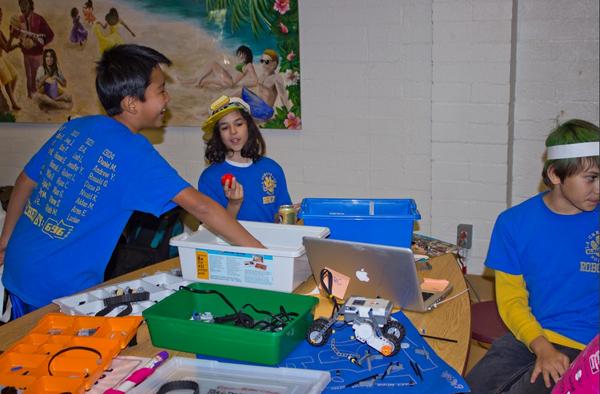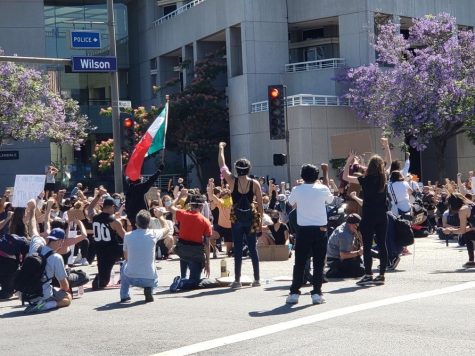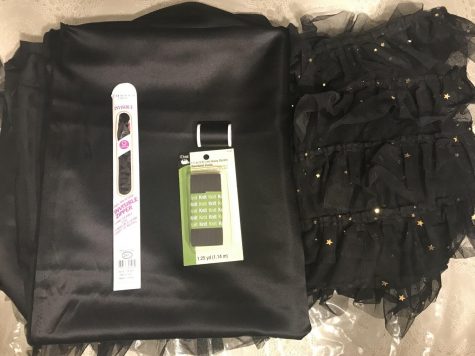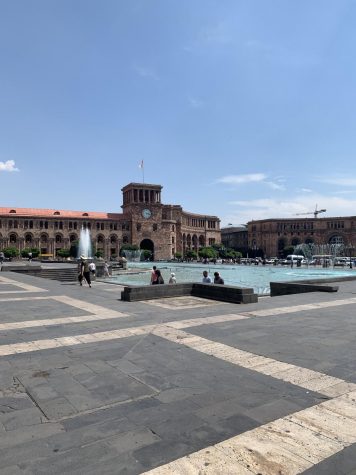FIRST Robotics Lego League
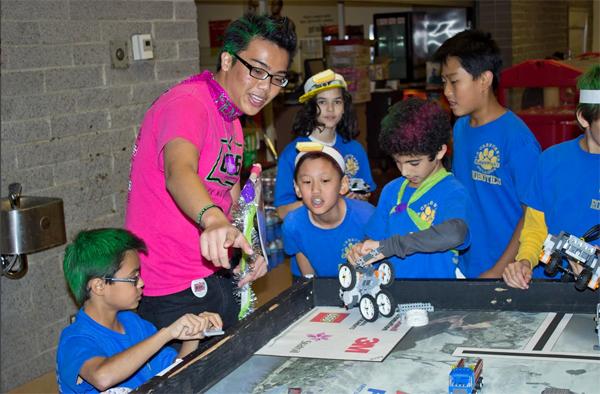
Senior Jerry Cortez works with children from the FIRST Lego League (FLL).
I am not good with kids. As an only child, I never understood what went through my little cousins’ heads when they came over, broke my toys and cried after I took them away. I could only conclude that kids were utterly devoid of common sense, just as I seemed to be when I signed up to coach a group of these kids for a Lego robotics competition I knew almost nothing about. Rowdy kids plus awkward teenager could only equal total mayhem, and at times, total mayhem did ensue — robots were broken, fingers were pointed and time-outs were issued. Still, through the laughing and crying, joys and frustrations, we persevered and produced some impressive results. By the end, I got something valuable out of the experience, and it wasn’t just community service.
Before I met the kids I’d spend the next 15 weeks coaching, I first looked up what this competition was all about. These kids are part of FIRST Lego League (FLL), which is a subset of FIRST, For the Inspiration and Recognition of Science and Technology. As the double-embedded acronym implies, FLL aims to get kids interested in science and technology through Lego robotics. FLL teams are comprised of nine- to fourteen-year-olds who participate in an annual three-part competition.
The first and most evident part of FLL is robots. FLL teams build and program Lego robots to solve Lego-sized challenges in a timed game. With each year comes a new game, complete with new challenges. This year’s game, Nature’s Fury, consists of natural-disaster-themed challenges like clearing Lego power lines and transporting Lego ambulances. Off the game field, judges also evaluate teams’ robots based on efficiency, durability and originality.
The Lego robots, however, don’t take up all of playtime. Part two of FLL requires teams to present a “project” in front of a panel of judges. FLL projects are essentially the 5th-grade little brother of Clark’s dreaded senior project — each FLL team must research and develop its own innovative and practical solution to a problem based on that year’s game. This year’s projects, then, would involve a lot of talking about the weather.
FLL’s third part, Core Values, is the simplest but arguably most important. At competition, yet another panel of judges determines each team’s commitment to Core Values — wacky terms such as “coopertition” and “gracious professionalism,” among others — through a series of questions and a short teamwork activity.
When I first walked into La Crescenta Elementary’s auditorium, where I’d be coaching these kids, I saw neither grace nor professionalism. I instead saw 31 laughing, screaming kids I had no idea how to turn off.
A firm voice did the job for me. “If you can hear me, clap twice!” yelled my fellow coach, Pauline Tasci. Despite Pauline’s anything-but-intimidating five-foot height, the cacophony sharpened into two claps, and all became silent. Pauline, a veteran coach and senior at Crescenta Valley High, thanked the kids and began to explain to them everything I had just learned about FLL. She periodically asked questions, ignoring the “ooh, ooh, pick me!”s and praising the quiet ones who answered correctly. If at any time the kids got out of hand, she got quiet herself and the kids would quickly emulate her. It was magic to me.
“I used to be in FLL myself, and I remember what these kids are going through,” Pauline tells me. “They don’t know what engineering is, and they’re scared of it, just like I was. So I try to make it fun!.. and it definitely helps that I’m their height,” she adds with a smirk.
Along with Pauline, I also had three other coaches and La Crescenta Elementary teacher Yvonne Quiñonez to help me out. “At the beginning it was a little chaotic,” reminisces Quiñonez, a 6th-grade teacher. “It gets even noisier than a classroom! Getting used to that level of noise is definitely a challenge.”
My backup, however, proved to be an unnecessary measure. Pauline soon revealed in her lecture a key Core Value: “We do the work to find solutions with guidance from our coaches and mentors.”
“So, who does the work?” she asked.
“We do the work!” came the reply.
“Who doesn’t do the work for you?”
“You don’t do the work for us!” What a relief.
After the overview, Pauline numbered the kids off into four teams. As each fourth kid approached me, the sub-groups the kids formed revealed our group’s incongruity. About half of each group had participated in FLL last year, and they were currently lamenting that they could not all form one overpowered veterans’ group.
“What did Pauline just tell you about coopertition?” I asked the biggest talker in the group, a kid named Aren.
“She said it was cooperation and competition,” Aren replied. “And I can cooperate with the veterans and compete with the new kids!” My kids clearly had a lot of work to do before they could present for Core Values.
At the next meeting, we began voting on team names. As with any sports team, establishing a team identity builds camaraderie — especially in the rare event that your team unanimously agrees on “Team Potato.” I will concede, however, that Team Potato’s loyalty pales in comparison to my fellow coach Saikiran Ramanan’s team — the Saikrobots.
“I swear I had nothing to do with it!” Saikiran, a Clark senior, claims. “One of them yelled it out and they all decided they loved it!”
The most loyal team of all, however, turned out to be Robotic Butter Circuits. Led by General Butters, formerly known as coach Aleksandr Savchenkov, RBC now salutes the General with every command he gives. Aleksandr, a Clark junior, says that although he appreciates his newfound authority, he had no idea how he got his promotion. “It’s some sort of Minecraft reference,” Aleksandr says he determined. “Something about how gold bars look like butter. But the g-word is now prohibited on this team, so don’t tell anyone.” I never imagined that team identities would develop into legal systems. I concluded that the children’s imaginations knew no bounds.
After that half-hour of christening creativity, we coaches attempted to funnel the kids’ inspiration into team projects. To develop solutions to natural disasters, we first needed natural disasters, so we had each team pick a geographic location and an accompanying disaster. RBC picked Hawaii and the Saikrobots picked Los Angeles. I hoped that my team would similarly decide on a pinpoint, easily reinforceable location.
Or perhaps not.
“Asia,” proposed a wacky kid named Lucian.
I sighed. “No, we can’t cover all of Asia,” I told him. “We have to pick something smaller.”
One of the kids mumbled, “Japan?”
“Yes, that’s great. We’ll do Japan. Does everyone agree?” Before anyone had a chance to dissent, I continued, “All right, it’s official, we’re doing Japan! Now, I want you all to think about what natural disasters happen in Japan.” I had lost my patience, and felt guilty for using my authority to take the easy way out. Still, if I’d given them free rein, they never would have reached a decision. Such are the dilemmas I was sure must plague parents and teachers everywhere.
It was not until the next meeting that we brought out the good stuff. I now sympathize with the extent to which parents buy toys — all became silent as soon as they saw us holding the boxes of Legos. As soon as the Legos hit the tables, our teams got to work. It was a relief, not having to constantly keep the kids focused on a project. I finally had time to argue with my fellow coaches over whose kids were the rowdiest, but we all agreed that the Legos were a universal pacifier.
We soon realized how terribly wrong we were. I returned to my table and again saw my team divided into two groups.The veterans’ group was diligently huddled around the motors, wires, and other important robot parts. The other motley group of new students, however, took little interest in the Legos’ robotic aspect. Lucian and his even wackier counterpart Ronald were developing Lego tops. Dana, a soft-spoken girl who I’m not sure even touched the Legos that day, summed up the situation. “Mr. Jerry, there aren’t enough pieces for all of us!”
“Definitely, the problem is that we don’t have enough kits to keep all of the kids occupied,” Aleksandr posits. “Three, maybe four or five kids can work together around a robot, but eight? Eight’s a bit much.” La Crescenta Elementary owns four Lego Mindstorms robotic kits, which could certainly supply a group of 20 kids. However, budgets keep supply from matching a growing demand, as is the common trend with public school programs. Still, we and the 31 kids had to be grateful for and make do with what we had.
We attempted to rectify the situation by splitting the kids into project and robot shifts. “So, what are your ideas for dealing with tsunamis in Japan?” I asked them. Ever the pragmatist, Ronald immediately suggested, “Let’s build a giant wall!”
Before flat-out rejecting the idea, I remembered what happened last time. Instead, I pulled a trick out of Pauline’s repertoire — I put him on the defensive.“You want to build a giant wall around all of Japan?” I asked. “How will people get to the beach?”
“We’ll put doors in it.”
“But won’t the tsunami break down the doors?”
“We’ll cover them when we know the tsunami is coming.”
Now we were getting somewhere. “How will you know the tsunami is coming?”
Gears turned in the depths of Ronald’s wild imagination. “We could put sensors out in the ocean?”
“That’s a great idea! A sensor is practical and innovative. Why don’t we do that?”
This time, everybody agreed. Rather than force my opinion on them, I helped them develop their own solution. I didn’t want to admit it, but I thought I was starting to get the hang of this “kid” thing.
Weeks passed, and both our robot and project began to take shape. Team Potato’s robot, dubbed “French Fry,” could traverse barriers and move ambulances. Team Potato’s project, a deployable tsunami sensor, combined gyroscopes and GPS for a roughly feasible cost of $8000 per sensor. As the kids learned each others’ names, Team Potato also started to work more as one group than two. Team Potato was no longer just a group of laughing, screaming kids. Now, they were my group of laughing, screaming kids.
Our FLL qualifier competition took place Nov. 24 at La Cañada High School. We arrived in high spirits, mainly due to the hairspray, face paint and sugary pastries Pauline brought along with the robots. For a few minutes I fretted over what my responsibilities were that day, but I soon discovered I wouldn’t have much to do at all. The judging panels and playing fields forbade coaches and mentors from entering — today was the kids’ time to shine.
And shine they did. Team Potato ran French Fry to traverse the barriers, move the ambulance and complete every challenge they undertook, and from what they told me, the judges loved the presentations. All of our teams did well — in fact, RBC and the Saikrobots even earned places in the FLL Los Angeles Finals.
“I’m really proud of them,” Saikiran says. “I admit, it was pretty bad at first, they didn’t even talk to each other or anything like that. But you can really see how they became a team, and I’m glad I helped them get there.”
The kids definitely learned a lot over the course of those fifteen weeks. They got to build a robot, solve real-world problems and work together. Contrary to my original opinion, these kids weren’t devoid of common sense at all — they were just learning, just as I was when I signed up to coach these kids for a Lego robotics competition. Still, even after all this, I don’t have the gall to claim that I’m good with kids. But thanks to Team Potato and the rest of FLL, I now have the willingness to try.



